tapuae-o-uenuku, kaikoura, christchurch, and moeraki
![]()
Melanie Massaro and I met one fateful Thursday night at the Robbie. Being typical grad students (she's doing her PhD in zoology), we got talking about our research projects. I learned a great deal about the reproduction of yellow-eyed penguins and she learned more than her share about intra-uterine devices. A few notable connections... (1) she's Adrian's friend (2) she's Maureen's supervisor (3) she knows Jim Quinn, who was at Otago on sabbatical a few years back, who taught me first year biology at McMaster, and who supervised John Haselmayer when John was at Otago doing field research with my friend Heather Shaw, also both from McMaster. After this Melanie and I saw each other at all the regular OUTC gatherings but didn't really get to know each other until we did Snowcraft together. Armed with alpine skills and heaps of enthusiasm, we were keen to head up into the mountains as soon as possible.
So it was that the idea for this trip was spawned during a Friday afternoon OUTC meeting. After considerable discussion, we've determined that neither of us actually came up with the idea of climbing Tapuae-O-Uenuku. I vaguely recalled seeing Danilo's trip report from a few years back on the OUTC website... but in my mind the name was just another incomprehensible jumble of vowels designed to make me appear inept, ignorant, and decidedly foreign. The plan was to head up to the Kaikoura Peninsula in the northeast part of the South Island, then a bit northwest to the Inland Kaikoura Ranges. We could then ascend Tapuae-O-Uenuku, which at 2885m is the highest peak in New Zealand outside the Southern Alps. Since it's situated on the east coast of the South Island, it's also one of the first places in the world to greet the dawn. On a clear day you can catch great views of the Pacific Ocean to the east, the Marlborough Sounds to the north, and the Southern Alps to the west. It's also higher than any mountain I've ever climbed (highest was Elsigenalp in Switzerland at 2350m). After a three-day mission in the mountains we planned to stop in Kaikoura to check out some wildlife, then back along the east coast to Dunedin with stops in Christchurch and Moeraki.
Wednesday, August 28
Left Dunedin around 9 am and headed north to Christchurch. Melanie had her CD player and two little speakers, and I was armed with my entire CD collection, so again we had some good tunes for the road. Stopped to chat with Rodney and Shirley, the owners of Heritage Expeditions, who Melanie works for during the NZ summer doing tours of the Sub-Antarctic Islands and Antarctica. Melanie had to drop off some gear that was being stored in a large container in preparation for this summer's trip. Drove north to Kaikoura where we stopped for a bite to eat around 5 pm. On the way there's a woman standing beside a truck, stopped by the side of the road. Beside her is a large placard that reads "Stock" in bold letters. I think, geez, what a weird way to sell your animals. Really, this means that a herd of stock is crossing the road just ahead. I am soon treated to a classic Kiwi experience - being in a car, surrounded by a confused flock of sheep running backwards and forwards across the road because they are too stupid to know where to go! Eventually the flock makes it across, and we continue to drive. Then on to Gladstone Downs where we set up our tent and bedded down for the night.
Thursday, August 29
Frost on the ground. Got sorted and met the farmer who owns the land... he's a typical Kiwi sheep farmer, small deep-set eyes, dusty hair, clothed in a Swanndri shirt and trousers, hands in pockets, lean from walking the pastures all day long with his loyal dog by his side, with a calm smile on his weathered face. If you're keen on doing this tramp, you need to give him a ring to get permission to walk over his land. He's more than happy to grant permission as long as you ask first. Also good security to have someone who's seen you go in and will see you come out.
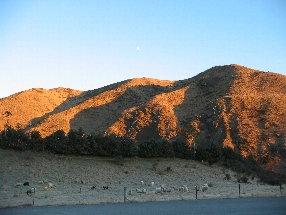
Dawn on the hills surrounding the sheep farm
Set off along the farmer's track and saw sheep and cows along the way. Descended into the gorge of the Hodder river. Saw heaps of goats wandering the hills with their babies. Keep an eye peeled for them, as they can loosen bits of rock that come cascading down the hills. Route is reasonably well marked with stone cairns. Also saw my first possum; dead from ingesting 1080, a poison they bait possum traps with. I've mentioned a few times that the native bush is being decimated by a few introduced animals (rabbits, stoats, ferrets, and possums), unchecked by natural predators. Basically you follow the river, keeping to the left branch where another river flows into the Hodder.

Melanie in the Hodder gorge
A few times the track leaves the gorge and ascends into the hills, sometimes rather steeply. Did 77 river crossings so our feet were quite wet by the time we reached the hut. About a 6-7 hour walk taking it easy including stops for lunch and route finding. Danilo advised us to take a spare pair of shoes for walking this segment of the track, since you want dry boots for climbing the mountain. We'd advise doing the same. The huts are owned by the Marlborough Tramping Club and are quite cosy. There are two huts, each with a metal bench, table, and chairs. One hut sleeps 6, the other sleeps 10. Last people to reach the hut were here August 4. Great views of the Hodder gorge. Here I sustained the only injury of my entire journey. When we reached the hut, I ran straight to the dunny (outhouse). Not realising that the screws were missing from the top hinge, I opened the door, which promptly fell onto my head and gave me a few moments of pain and embarrassment!
Friday, August 30
Got up at 5:30 am and left the hut at 6:30 am. Walked along a track across scree slopes. Reached the confluence of the Hodder and Staircase Rivers, and had to cross both. Stashed our wet shoes and donned our boots. Followed a track on the true right of the Staircase River, again marked with stone cairns. Once we hit permanent snow we strapped on our crampons and helmets, and started walking with ice axes.
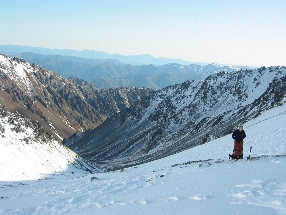
Melanie on the slopes with ice axe and crampons
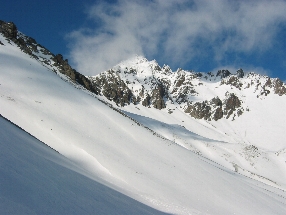
Our goal, as seen from the slopes above the basin of the Staircase River
Gorgeous views of the surrounding mountain ranges to the west, and hills to the north. Some cloud cover so it was difficult to see the peaks around us. Located a peak we thought was Tapuae-O-Uenuku and headed towards it. Melanie lost her footing and slid down a small icy slope. All I knew was that one moment Melanie was in front of me, and the next her ice axe was jammed into the slope beside me, but she was sliding down the hill. Hey Mel, when you self-arrest, you're supposed to hang ON to the ice axe! No damage incurred except a scraped cheek. All she could think about while sliding down was that she wanted to stop quickly so that she didn't have to climb up very far...
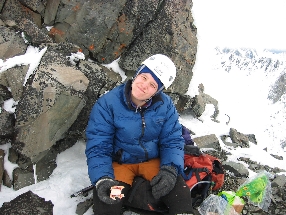
Lunch somewhere high (around 2400 m?)
Visibility got a bit worse but walking was still OK. Ascended some steeper slopes and eventually reached the summit. We'd been told that climbing Tapuae-O-Uenuku was like tramping, only a bit higher up. What we did was certainly more like mountaineering. Cloud cover meant that we had limited visibility, but caught some glimpses of the mountains to the east, and even the Pacific Ocean!
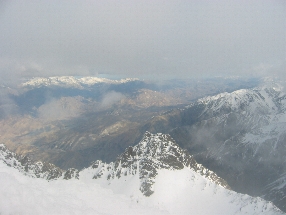
The view from 2877 m
Came down again and were relieved to finally be on flat ground again. Back to the hut after just over 12 hours of tramping. Decided Christine is the Queen of Uphill, and Melanie is the Queen of Downhill.
Saturday, August 31
Woke up and had some brekky. Melanie sees a postcard in the hut with a picture of the mountain we climbed... except the caption says Mt Alarm and not Tapuae-O-Uenuku. Uh, Christine? Give us the map, would you? We spent some time poring over the topo maps trying to figure out what we climbed. Mt Alarm (2877 m) is just south of Tapuae-O-Uenuku, and only 8 m lower, so with impaired visibility of the peaks not a difficult mistake to make. The only difference is that the contour lines are a bit different... Left the hut and tramped back to Gladstone Downs. Got sorted and had a chat with the farmer, who was moving a flock of sheep through the pastures with the aid of three trusty sheep dogs. Soon realised the car battery was flat. I went to fetch the farmer, who was in the process of slaughtering one of the sheep. Got a boost, then drove to Kaikoura and stayed in the Dusky Lodge backpackers. A great deal, with free breakfast, free cream buns, a spa pool, fire places... Cleared some of my emails. We were keen to hit the spa pool, but too knackered to do anything but climb into bed.
Sunday, September 1
Spent the day in Kaikoura, which means "to feast on crayfish" in Maori (kai = food, koura = crayfish). In one version of the Maui myth of the creation of NZ, the North Island was the fish (Te Ika a Maui), the South Island the canoe (Te Waka a Maui), and the Kaikoura Peninsula was the thwart (Te Taumanu o te Waka a Maui) against which Maui braced himself as he drew the fish to the surface. The Kaikoura Peninsula used to be a volcanic island, and has since become attached to the mainland by the gradual accumulation of silt, sand, and stones. There is also a large oceanic shelf close to the mainland, meaning that the sea floor drops dramatically very close to shore, and therefore there is an abundance of sea life near the mainland. Did the tourist thing all day long. Went to Dolphin Encounters (you need to reserve a space a few days or weeks in advance) at 8:30 am and met our guide Jackie. They provided us with wetsuits and snorkels, and me with prescription goggles! Watched a video, then took the bus to the harbour and caught a catamaran heading out to sea. When we sighted a pod of wild dolphins, we leapt into the water and started swimming with them! They're quite curious and intelligent, so you have to entertain them if you want them to stay around. I made all sorts of noises, altering the sounds every few minutes since I reckoned they'd get bored quickly. Two other strategies were to swim in circles and to dive down. I was pretty much constantly surrounded by about 15-20 Dusky dolphins swimming around me.

Dusky dolphins as photographed from the catamaran
Centimetres from my face, but we were advised not to touch them since they're wild. Really fun to look one of them in the eye and swim in circles together. Felt like an awkward human - I swam slowly, couldn't keep warm underwater without a wetsuit, couldn't breathe underwater without a snorkle, and couldn't see underwater without a prescription mask. Wanted nothing more than to take off all the gear and be able to swim with them, but alas I'm restricted by millions of years of genetic evolution. They're also quite promiscuous - researchers have noted one female mating five times with three separate males in the space of... two minutes! Hot chocolate and gingernuts for those of us who didn't get seasick (about half of the 15 on the ship). Also caught sight of two Hector's dolphins, the world's smallest dolphins, recognisable by their round dorsal fins. In the afternoon, Jackie took us on a bird tour. Got out to sea then threw out a small net with frozen (but very, very stinky!) shark's liver. Soon we were surrounded by cape pigeons.
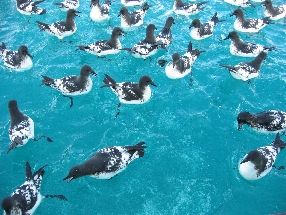
Cape pigeons
Later some albatrosses came in, and a few giant petrels.
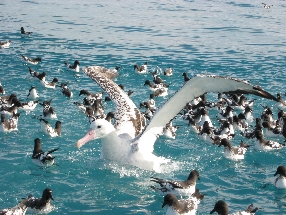
Albatross landing among the cape pigeons
Did this a few times at various points out from shore. There was also some fresh shark's liver, which I grabbed with a rubber glove and fed to one of the albatrosses! Very cool. Cruised back to shore, jumped in our car, and headed down to Christchurch. Arrived at the house of Baden Norris, a friend of Melanie's. He's been to Antarctica 10 times, and was curator of the Antarctica exhibit at the Canterbury Museum in Christchurch until he retired this year. He can't cook ; P so he went out to buy us fish and chips, which we devoured ferociously. Sat and chatted, played with his many cats, then into bed at the late hour of 10 pm.
Monday, September 2
Up for breakfast. Fed the ducks outside Baden's house. Checked out the Antarctica Museum with Baden as tour guide. First to the pole was Amundsen, a Norwegian, followed months later by Scott, a Brit. Saw sledges, clothing, drugs from Burroughs Wellcome (which later became Glaxo Wellcome - a company I worked for in 1998), sno-ccats, and assorted gear. Got a shot of Baden holding a jar of 100 year old salt from Shackleton's expedition.

Melanie, Baden holding a jar of really old salt, and me, taken in the offices
of the Canterbury Museum
Back in the 1960s, Baden was one of the volunteers to clear out the huts from the old expeditions. Saw a photo of him from 1964 in Discovery Hut. Left Christchurch with overcast skies, thankful that the weather held this long. It's the lambing season, so we saw heaps of adorable fluffy white lambs leaping around the fields and suckling their mothers. Checked out the Moeraki Boulders in Oamaru. Arrived back in Dunedin.

Yours truly trying to balance on one of the boulders at Moeraki
I refer to Melanie as a legend for driving the entire way (~1500 km round-trip) since her car is a manual which I am incapable of driving. I vow to learn manual one day.
Tuesday, September 3
Melanie's flatmate informs us that Tapuae-O-Uenuku is quite flat on top, and 10 people can easily stand there together. We are convinced that we've climbed Mt Alarm, not too shabby.
Love Christine
[
main ] [ letters and photos] [ curriculum vitae ] [ links ]